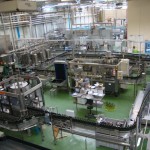My recent visit to Emilia Romagna left me excited about the possibilities for co-operatives in Scotland. In this third instalment I share insights in how collaboration is core in this famous European co-operative region.
Before visiting Emilia Romagna I was very much aware that it is the ‘home’ of business consortia and industrial clusters. Robert Putman (Professor at Harvard University) identified culture as a key driver. I was keen to gain a deeper understanding of this and what else was driving this collective approach.
Collaboration is the norm in this region, with companies collaborating while remaining competitors. The form of collaboration varies from relationships centred on a specific contract to fully constituted ventures established to enable on-going business. Firms are highly specialised and exist as part of a co-operative production system and as such, there is a genuine desire to work with others. Success of one firm is intimately connected to success of others – a recipe for success.
Emilia Romagna is known for leadership in the production of specialised manufacturing machinery – expertise that builds upon its strengths in agriculture, ceramics, textiles and packaging. Collaboration lies at the core – creating vibrant industrial clusters. Often businesses will be members of more than one consortium or industrial cluster. Similar practices exist within the service sector.
Throughout the world collaboration is well established in agriculture. In Italy farmers owning vineyards are members of consortium co-operatives which harvest grapes on their behalf and the latter are members of secondary consortia that produce the wine.
During my stay, I enjoyed a visit to one of the Cervico Group’s plants.
The co-operative was established in 1963 and is now number one producer in boxed wine and number two in packaged wine (bottles/Tetra Pak) in Italy.
The business is self-financing and has recently undertaken major capital investment. I was fascinated by the pallet storage system’s use of gravity to move the next pallet into position!
I was also interested in the finance and services consortia. These are a relatively recent development for the region. Legislation was passed in 1991 to encourage the creation of ‘business clusters’ and ‘inter-firm co-operation’ with three types of consortia emerging; credit guarantee, export and services.
Credit guarantee consortia operate like lending circles, with individual loans guaranteed by other firms in the consortium. Business members pay a fee, which may be supplemented by the government. The resulting ‘guarantee fund’ is deposited in a credit or banking institute, with which a specific agreement has been established. It is used as collateral for credit extended to members. By doing it this way the risk associated with lending is divided between the bank and the credit co-op, or borne completely by the latter.
The advantages to entrepreneurs is that they do not need to provide collateral based on personal assets and are able to access credit at relatively favourable terms. A positive aspect of this model is that the default rate is a fraction of that of a normal bank – due to the credit guarantee consortia’s role in monitoring. In Emilia Romagna the insolvency rate by firms guaranteed by the consortium is less than one per cent compared to a national average of ten per cent.
Export consortia promote members’ goods/services abroad and facilitate their export. The model is now well established with approximately 350 consortia. The high number is the result of the law establishing public funding for export consortia with more than eight members (small & medium sized enterprises). Government will contribute up to forty per cent annually to operating costs (higher level in first five years and for those based in Southern Italy).
Consortia comprise groups of firms that pay a one-off lump sum to underwrite the consortia’s capital and an annual membership fee for operating costs. Services vary and include market information, translation, secretarial, credit guarantees, merchandising, franchising and legal assistance. Consortia may also benefit from tax reductions – the ‘indivisible reserve’ is tax exempt and so too are the services rendered and acquired by the consortia. I was told about a textiles consortium in Prato that worked with its members to produce a new image, developed an export culture and other ventures to improve competiveness.
Services consortia play an important role in providing strategic advice, payroll, marketing, bidding and fundraising guidance to their members. They offer the advantage of access to skills and economies of scale.
So some further lessons for us in Scotland. It was crystal clear that there is significant benefit to be gained from working with other businesses in order to achieve scale in buying, producing and selling. There is scope for much wider levels of adoption of this model in Scotland – especially for export purposes.
Until next time…
And remember…think ‘co-operatively’!
Sarah Deas is the chief executive of Co-operative Development Scotland, a Scottish Enterprise subsidiary, established to help companies grow by setting up consortium, employee-owned and community businesses. It works in partnership with Highlands and Islands Enterprise.

